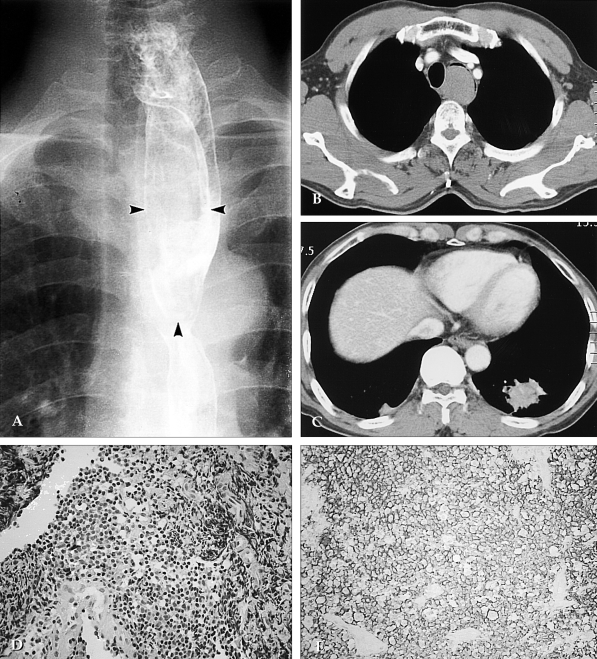1. John DV Jr, Levin B, Salem P. Feldman M, Scharschmidt BF, Sleisenger MN, editors. Intestinal lymphomas, including immunoproliferative small intestinal disease. Sleisenger & Fordtran's Gastrointestinal and liver disease. 1988. Philadelphia: Saunders;p. 1844–1857.
2. Oğuzkurt L, Karabulut N, Çakmakci E, Besim A. Primary non-Hodgkin's lymphoma of the esophagus. Abdom Imaging. 1997; 22:8–10. PMID:
9000346.
3. Isaacson PG. Knowles DM, editor. Gastrointestinal lymphomas and lymphoid hyperplasias. Neoplastic hematopathology. 2001. Philadelphia: Lippincott Williams & Wilkins;p. 1235–1261.
4. Lee HJ, Han JK, Kim TK, Kim YH, Kim AY, Kim KW, et al. Primary colorectal lymphoma: spectrum of imaging findings with pathologic correlation. Eur Radiol. 2002; 12:2242–2249. PMID:
12195476.

5. Shim CS, Lee JS, Kim JO, Cho JY, Lee MS, Jin SY, et al. A case of primary esophageal B-cell lymphoma of MALT type, Presenting as a submucosal tumor. J Korean Med Sci. 2003; 18:120–124. PMID:
12589101.

6. Weston AP, Cherian R, Horvat RT, Lawrinenko V, Dixon A, McGregor D. Mucosa-associated lymphoid tissue (MALT) in Barrett's esophagus: prospective evaluation and association with gastric MALT, MALT lymphoma, and Helicobacter pylori. Am J Gastroenterol. 1997; 92:800–804. PMID:
9149188.
7. Raderer M, Vorbeck F, Formanek M, Osterreicher C, Valencak J, Penz M, et al. Importance of extensive staging in patients with mucosa-associated lymphoid tissue (MALT)-type lymphoma. Br J Cancer. 2000; 83:454–457. PMID:
10945490.

8. Nishiyama Y, Yamamoto Y, Ono Y, Satoh K, Ohkawa M, Yamauchi A, et al. Visualization of esophageal non-Hodgkin's lymphoma with Ga-67 scintigraphy. Ann Nucl Med. 1999; 13:419–421. PMID:
10656277.

9. Hosaka S, Nakamura N, Akamatsu T, Fujisawa T, Ogiwara Y, Kiyosawa K, et al. A case of primary low grade mucosa associated lymphoid tissue (MALT) lymphoma of the oesophagus. Gut. 2002; 51:281–284. PMID:
12117895.

10. Kitamoto Y, Hasegawa M, Ishikawa H, Saito J, Yamakawa M, Kojima M, et al. Mucosa-associated lymphoid tissue lymphoma of the esophagus: A case report. J Clin Gastroenterol. 2003; 36:414–416. PMID:
12702984.

11. Yoshino T, Ichimura K, Mannami T, Takase S, Ohara N, Okada H, et al. Multiple organ mucosa-associated lymphoid tissue lymphomas often involve the intestine. Cancer. 2001; 91:346–353. PMID:
11180081.

12. Sminia T, van der Brugge-Gamelkoorn GJ, Jeurissen SH. Structure and function of bronchus-associated lymphoid tissue (BALT). Crit Rev Immunol. 1989; 9:119–150. PMID:
2663024.
13. Pabst R. Is BALT a major component of the human lung immune system? Immunol Today. 1992; 13:119–122. PMID:
1580992.

14. McCulloch GL, Sinnatamby R, Stewart S, Goddard M, Flower CDR. High-resolution computed tomographic appearance of MALToma of the lung. Eur Radiol. 1998; 8:1669–1673. PMID:
9866784.

15. Lee DK, Im JG, Lee KS, Lee JS, Seo JB, Goo JM, et al. B-cell lymphoma of bronchus-associated lymphoid tissue (BALT): CT features in 10 patients. J Comput Assist Tomogr. 2000; 24:30–34. PMID:
10667654.

16. Lee IJ, Kim SH, Koo SH, Kim HB, Hwang DH, Lee KS, et al. Bronchus-associated lymphoid tissue (BALT) lymphoma of the lung showing mosaic pattern of inhomogeneous attenuation on thin-section CT: A case report. Korean J Radiol. 2000; 1:159–161. PMID:
11752947.

17. Takamori M, Noma S, Kobashi Y, Inoue T, Gohma I, Mino M, et al. CT findings of BALTOMA. Radiat Med. 1999; 17:349–354. PMID:
10593284.
18. Varoczy L, Gergely L, Illes A. Diagnostics and treatment of pulmonary BALT lymphoma: a report on four cases. Ann Hematol. 2003; 82:363–366. PMID:
12728338.





 PDF
PDF ePub
ePub Citation
Citation Print
Print


 XML Download
XML Download